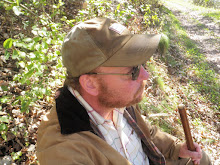How to destroy a fishery.
- Cut down trees using clear-cutting techniques. Do no soil stabilization.
- Place a dam on the river with little or no fish passage opportunities.
- Build homes and Mc mansions in the riparian habitat.
- Answer angler's concerns about dwindling supplies of andronomous fish by opening a fish hatchery and dumping pellet heads in to replace the wild fish.
- Let the hatchery fish spawn with the wild fish, thus diluting millions of years of genetic evolution.
Game over.
This is what California, Washington, Oregon, and British Columbia have been doing for the last hundred years.
Einstein defined insanity as the act of "Doing the same thing again and again, but expecting different results."
If this is accurate then some people in Oregon are insane. After all, in 2009, applying 19th century thinking to our environment can only lead to disaster.
____________________________
From CF Burkheimer Fly Rods comes this little gem.
Posted on April 30, 2009
The Siletz River drains the rainiest part of the Oregon Coast Range, traveling a tortuous path through steep forestlands to the Pacific Ocean. The Siletz isn’t a large or famous destination river, but it is a unique gem, and supports more species of anadromous fish than any other river in the entire state of Oregon. Spring and fall chinook, fall coho, summer and winter steelhead, chum salmon, and sea run cutthroat are all native to the Siletz basin. Lamprey too! Siletz summer steelhead are particularly unique, being the only native summer race of steelhead in the entire Oregon Coast Range, with a few hundred wild fish returning annually to spawning grounds in the upper basin. All of these fish species manage to survive despite intense past and present logging in the basin, continued introductions of hatchery fish, and documented cases of poaching each year. What could make matters worse?
A dam.
Political forces in Polk County are currently evaluating the feasibility of damming the Siletz River. The proposed dam on the South Fork Siletz River would be 100’ tall and create a reservoir 5 miles long and 3 miles wide. A total of 20 usable river miles of mainstem and tributary habitats would be blocked. The best and preferred chinook spawning habitat in the South Fork Siletz would be directly inundated by the dam. The remaining stream reaches in headwater tributaries above the reservoir would become isolated from one another, confounding the seasonal migration of juvenile fish among various tributaries essential for their survival. The lake itself would become a gauntlet of invasive stillwater bass, bullfrogs, and other species that always seem to benefit at the expense of native salmonids. In an unprecedented era of dam removal, why on Earth would Polk County propose now to dam the most diverse anadromous river in Oregon?
Follow the money. The headwaters of the Siletz River lie within Polk County, which in recent years has seen increased development as a bedroom community for the Oregon State Capital. Growth requires water, and continued growth will strain existing Polk County water supplies, jeopardizing further development and cash influx. Polk County borders the mighty Willamette River, which provides an abundant and perfectly usable source of drinking water, with communities both immediately upstream (Corvallis) and downstream (Wilsonville) treating Willamette River water to excellent drinking quality. Polk County has an open option to purchase additional Willamette River water rights from the nearby city of Adair, but hasn’t done much to explore this option. With Willamette water so close and readily available, what makes damming a remote coastal river so appealing?
Follow the money, again. Historically, the creation of large reservoirs in remote areas in Oregon and elsewhere has promoted development and recreational tourism. Landowners along the Siletz River could stand to gain handsomely from a new dam and reservoir. Riverside lands formerly owned by Boise Cascade and now deemed unproductive timberlands were purchased in recent years by Forest Capital Partners, a land holding company with a long history of making lucrative land deals in forestlands. Their clients are wealthy investors, not family loggers in Oregon. Perhaps coincidentally, the Polk County commissioner who has been spearheading the dam evaluation effort has a background in real estate, heavy construction, and construction engineering. That’s one dam coincidence after another.
Contact Commissioner Mike Propes and the other Polk County Commissioners, and let them know what you think of damming the most diverse anadromous salmonid river in Oregon.
Mike Propes: mike.propes@co.polk.or.us & mikepropes50@hotmail.com
Tom Ritchey: Ritchey.Tom@co.polk.or.us
Ron Dodge: Dodge.Ron@co.polk.or.us
















